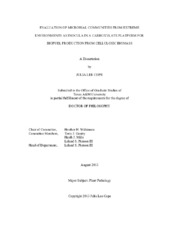| dc.description.abstract | The carboxylate biofuels platform (CBP) involves the conversion of cellulosic biomass into carboxylate salts by a mixed microbial community. Chemical engineering approaches to convert these salts to a variety of fuels (diesel, gasoline, jet fuel) are well established. However, prior to initiation of this project, little was known about the influence of inoculum source on platform performance. The studies in this dissertation test the hypothesis that microbial communities from particular environments in nature (e.g. saline and/or thermal sediments) are pre-adapted to similar industrial process conditions and, therefore, exhibit superior performances. We screened an extensive collection of sediment samples from extreme environments across a wide geographic range to identify and characterize microbial communities with superior performances in the CBP. I sought to identify aspects of soil chemistry associated with superior CBP fermentation performance. We showed that CBP productivity was influenced by both fermentation conditions and inocula, thus is clearly reasonable to expect both can be optimized to target desired outcomes. Also, we learned that fermentation performance is not as simple as finding one soil parameter that leads to increases in all performance parameters. Rather, there are complex multivariate relationships that are likely indicative of trade-offs associated within the microbial communities.
An analysis of targeted locus pyrosequence data for communities with superior performances in the fermentations provides clear associations between particular bacterial taxa and particular performance parameters. Further, I compared microbial community compositions across three different process screen technologies employed in research to understand and optimize CBP fermentations. Finally, we assembled and characterized an isolate library generated from a systematic culture approach. Based on partial 16S rRNA gene sequencing, I estimated operational taxonomic units (OTUs), and inferred a phylogeny of the OTUs. This isolate library will serve as a tool for future studies of assembled communities and bacterial adaptations useful within the CBP fermentations.
Taken together the tools and results developed in this dissertation provide for refined hypotheses for optimizing inoculum identification, community composition, and process conditions for this important second generation biofuel platform. | en |


